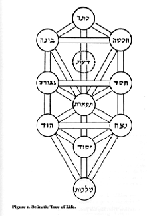Some types of esoteric knowledge.
- mythological/cosmologiucal/speculation (text 1) i.nam.gis.hur.an.ki.a
- temurah, gematria, notariqon (texts 1,2) ditto, Zababa exposition
- alchemy (text 3)
- mystery rituals, inspiration (texts 4,5) secret Ishtar, inspiration for
Erra
Words describing secre knowledge:
Examples:
Perhaps Akkadian qabu is related to Hebrew qannal(ah);
qabu means "recite" or "a recitation."
TEXT I (portion of i.NAM.gis.hur.an.ki.a "(Word?) of the corresponding things
of Heaven and the Underworld" - transcription for comparison with copy)
1) I inbu sin assu anu imbu sumsu gabbi
AN AN NE GIS GI kilallan tamartu
ud.I.kam uskaru anu
2) I ab.kar sin appa arhu littu arhu littu
maslu kara ganatenu karu tapala gana
a.sa maslu agu ud.7.kam kalit ea
3) I(....) sin bel purusse esu 30 2 eni bel
30 a.ra 30 15 aparu agu ud.15.kam
kippattu enlil
4) (...)enlil talim ea nannu SES talim SES
ID naru nara enlil
5) ... mu.didli suen.na.ke
6) ...ilu restu abi ilani 60 anu
7) ...U gasir re'u su su kissat
sar kissati 50 enlil
8) ...sar apsi bel naqbi 40 ea
9) ...imbu bel purusse arhi 30 sin
10) ..U en bel dipari kippatu ud 20 samas
11) ...zunni u UB rigmu 6 adad
12) ................................ 10 bel
marduk
13) ..................... 15 istar
belet
ilani
14) .. ku bel kakki sa kima
sumisuma nabu enlil 50 ninurta
mar
enlil
15) ... PA AD an.ki an an.ta ki.ta
sar e.de en 600 11 nergal
sakkan
16) ... tab 2 10 a.ra 2 20 tappe 20 10 gibil
nusku
17) ... same sa me uras
banu
18) an giri ki
19) nishu i.NAM.gis.hur.an.ki.a
qati
20) ...nisrti apkalli la mudu la immar
21) tuppi nabuzuqupkena mar marduksumiqisa
tupsarri liplipi gabbilanires rab tupsare
Notice that the tablet has 21 lines (21 is a sacred name of Anu). Nabuzuqupkena
was a scribe who lived approximately 760-680 BCE, and would have been perhaps
the "chief scribe" under Sargon II and Sennacherib. Sargon II has pradmined the most famous example of
cuneifrom gematria: "I made the length of the wall (of Nineveh) to correspond to the value of
my name: 16,280." This puzzle has not yet been solved satisfactorily, despite 3 attempts (including my own).




